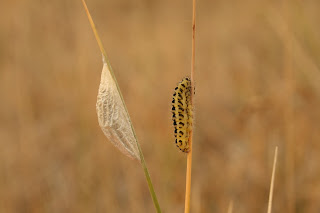Juvenile Sandwich Tern on the Point
(photograph courtesey of Richard Porter)
Visitors on a recent guided walk were lucky enough to witness Six-spot Burnet moths emerging from their pupae.

Pupae beside caterpillar
Moth emerging/ Moths mating
Six-spot Burnet moths can be seen feeding on the various plants found on the reserve including thistles. These attract a host of nectar-seeking species such as these wonderful iridescent green Forester moths...
...and this Essex Skipper, so-named because it was discovered in Essex in 1889. Now widespread across the country, it differs from the Small Skipper in that the tips of the antennae are black.
Sand Digger Wasps can often be seen amongst the dunes on Blakeney Point. These parasitic wasps have an interesting life cycle. They first paralyse their prey and then drag it into a cavity they have dug in the sand. They then lay their eggs within the prey item and seal them in. When the eggs hatch, there is a ready source of food straight away - in this case a paralysed caterpillar. Once this is devoured they emerge out of the sand.
(insect photography by Matt)
Today's low tide seal count was rather impressive, totaling over a thousand seals: 887 Grey and 208 Common. We recorded seals on today's National Whale and Dolphin Watch at Cley Beach, but sadly no Harbour Porpoises this time. It is always worth looking as they can sometimes be seen off the Norfolk Coast.
The Cat's-ears, which are abundant amongst the sand dunes, have now all gone to seed. While they were still in flower we captured this footage showing the flowers opening in the morning and closing in the afternoon.
To finish with, here is some time-lapse footage of the tide coming in and going out of Blakeney Harbour, captured from the top of the Lifeboat House.
- This week's Sunday evening blog post was written by Ajay and Matt.








Excellent news about the sandwich terns, and lovely photos of the moths and butterflies too.
ReplyDeleteBrownsea Island fledged 121 from 180 pairs of STs this summer from their shingle islands in the lagoon.